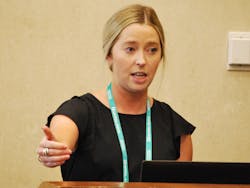Oil and gas producer pumps up operations with SCADA
Canvas Energy, an Oklahoma City-based independent oil and gas producer with operations in the oil and liquids-rich portion of the Anadarko Basin in Oklahoma, has a future vision it calls “Operation by Exception (OBE).” Over the last decade, a key component of its successful operation, particularly in a business with a need to be flexible to the ups and downs of the oil market, is its supervisory control and data acquisition, or SCADA, system.
Getting through its digital transformation to where its automated processes and data usage are today has been a journey, according to Kylie Odorisio, production engineer at Canvas, who was on hand at this week’s Emerson Exchange to discuss its transformation.
“We started looking at SCADA just under 10 years ago. Our first question was that we always had a flat infrastructure system. So being able to integrate different data sources and being able to bolt-on different platforms was our first-step mission,” Odorisio told the audience.
The company, working with Emerson’s Zedi SaaS SCADA unit and Emerson impact partner Vinson Process Controls, started its journey with tank-level monitoring, tank-level alarm and artificial lift, real-time pressure monitoring, to name a few projects. Odorisio said the ultimate goal of the digital transformation was to “empower our employees to make correct decisions,” which is the basis of the company’s OBE strategy.
That entails both field-level transformation and office-level transformation, according to Odorisio. At the field-level, it’s about using the data to provide successful operational improvements. At the office-level it is centered on creating aggregated KPIs that can be further digested into trends and patterns for making strategic business decisions.
Key to success
The company needed to satisfy three key areas in its digital transformation. It needed its operation to be proactive. It needed to be able to leverage multi-disciplined personnel, and it needed to be scalable for further mergers and acquisition, a point vital to a capital-aggressive company such as Canvas. To get there it needed a long-term technology partner, according to Emerson’s Adin Nand, director of business development for Zedi Saas SCADA. Nand and Jared Frederickson, business unit leader for digital transformation at Vinson Process Controls, both joined Odorisio during the presentation.
“During our initial meeting with Canvas, they sort of stopped us and said, ‘We have a vision. We don’t know exactly how we are going to get there, but we want a long-term partner to help us figure it out,’” Nand said. “Obviously, we said, ‘Let’s do this.’”
Frederickson added that his company’s domain space expertise—it has worked with Canvas since 2014 and in oil and gas for quite longer—was another difference maker. He also pointed to Emerson’s extensive technology stack as the clincher.
“We can bring Emerson’s entire portfolio in and leverage it to the Canvas operation-by-exception platform,” he said.
Frederickson added the transformation centered on reaching near autonomous operations that would be driven by outcomes. A stack of Rosemount wireless sensors, Vinson’s ProductionManager Edge and cloud analytics via Emerson Zedi SaaS SCADA, allowed the companies to apply several machine learning and artificial intelligence tactics to achieve success.
Up to the task
One of the biggest aspects of the system design is that it allows for speed in a world of rapidly changing market conditions. “Sometimes you have to do a lot with very little. Sometimes you buy assets and you need to have transparency in your equipment [when onboarding],” Frederickson said.
That was particularly true for Canvas, which saw one of its biggest business results from the new system when the company made a recent asset acquisition that added approximately 1,900 barrels of oil equivalent (BOE) per day to its production over an additional 39,000 net acres of operations, according to Odorisio.
“Drilling inventory existed and it had a pretty strong production base, but one thing we also saw was lots of hardware on site that we felt we could better utilize than what the current operator was doing,” Odorisio said. “Upon the acquisition, we used that existing hardware and brought it into the SCADA platform within 60 days at a low cost of two cents per BOE.
“Rather than going to each site, day-by-day, which is what the previous operator was doing, we were able to do everything directly from the office and/or another field,” she continued. “We feel that is a strong competitive advantage from a merger and acquisitions standpoint. It is a quantified value beyond just production.”
The ability to reduce field miles and better engage in remote operations is a broader business advantage to Canvas’ SCADA system. “Being able to route data into our field data capture as well as layering on some addition visibility with our SCADA system we allow our lease operators to make virtual visits,” Odorisio said. “If there are now critical alarms and they are comfortable that there is likely not a spill, rather than making physical trips we let them virtually visit.”
The results, she said, include a reduction of more than 27,000 field miles driven per year. The company has reduced its physical field visits by 20%, according to its most recent ESG report.
In the end, the partnership was able to lead Canvas Energy to success in achieving it’s three primary goals of the digital transformation: creating proactive operations, leveraging its multidiscipline personnel to help its lease operators and field staff, and create scalability to accommodate its future M&A activities.


